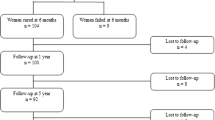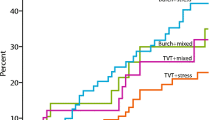Abstract
To investigate whether there are any demographic, clinical, or urodynamic variables associated with an increased risk of failure in women undergoing surgery with tension-free vaginal tape (TVT). We retrospectively analysed 325 consecutive patients who had been operated with the TVT procedure. Patients were assessed with a complete history, physical examination, and urodynamic testing. The operation was done under local or epidural anesthesia and any further surgical procedure was added as indicated. The postoperative evaluation included collection of data on intra- and postoperative complications and analysis of outcomes. The outcome of surgical treatment was evaluated subjectively and objectively. The Statistical Package for Social Sciences (SPSS, Chicago, Illinois, USA) was used for data analysis; P<0.05 was considered significant. The overall complication rate was 14%, voiding dysfunction being the most common. Three hundred and one women were available for the analysis of surgical outcome and the mean follow-up was 34+12 months (median 32 months). Subjectively, 269 women (89%) were cured by the procedure and 13 (4.3%) reported marked improvement. An objective cure was achieved in 263 (87%); 38 patients still having leakage while coughing during postoperative cystometry. Among the numerous presumed risk factors for failed antiincontinence surgery only urethral hypomobility and recurrent stress urinary incontinence were significantly associated with failure of the TVT procedure in our study. However, even in these complicated situations, the cure rate was more than 70%.
Similar content being viewed by others
References
Nilsson CG, Falconer C, Rezapour M (2004) Seven-year follow-up of the tension-free vaginal tape procedure for treatment of urinary incontinence. Obstet Gynecol 104:1259–1262
Lo Ts, Horng SG, Chang CL et al (2002) Tension-free vaginal tape procedure after previous failure in incontinence surgery. Urology 60:57–61
Rardin CR, Kohli N, Rosenblatt PL et al (2002) Tension-free vaginal tape: outcomes among women with primary versus recurrent stress urinary incontinence. Obstet Gynecol 100:893–897
Rezapour M, Falconer C, Ulmsten U (2001) Tension-free vaginal tape (TVT) in stress incontinent women with intrinsic sphincter deficiency (ISD)—a long-term follow-up. Int Urogynecol J 12(Suppl 2):S12–S14
Liapis A, Bakas P, Salamalekis E et al (2004) Tension-free vaginal tape (TVT) in women with low urethral closure pressure. Eur J Obstet Gynecol Reprod Biol 116(1):67–70
Meschia M, Pifarotti P, Spennacchio M et al (2004) A randomized comparison of tension-free vaginal tape and endopelvic fascia plication in women with genital prolapse and occult stress urinary incontinence. Am J Obstet Gynecol 190:609–613
Groutz A, Gold R, Pauzner D et al (2004) Tension-free vaginal tape (TVT) for the treatment of occult stress urinary incontinence in women undergoing prolapse repair: a prospective study of 100 consecutive cases. Neurourol Urodyn 23:632–635
Bump RC, Mattiasson A, Bo K et al (1996) The standardization of terminology of female pelvic organ prolapse and pelvic floor dysfunction. Am J Obstet Gynecol 175:10–17
Abrams P, Cardozo L, Fall M et al (2002) The standardization of terminology of lower urinary tract function: report from the Standardization Sub-committee of the International Continence Society. Am J Obstet Gynecol 187:116–126
Ulmsten U, Henriksson L, Johnson P et al (1996) An ambulatory surgical procedure under local anesthesia for treatment of female urinary incontinence. Int Urogynecol J 7:81–86
Cetinel B, Demirkesen O, Onal B et al (2004) Are there any factors predicting the cure and complication rates of tension-free vaginal tape? Int Urogynecol J 15:188–193
Deval B, Jeffry L, Al Najjar F et al (2002) Determinants of patient dissatisfaction after a tension-free vaginal tape procedure for urinary incontinence. J Urol 167:2093–2097
Wang AC, Chen MC (2001) Randomized comparison of local versus epidural anesthesia for tension-free vaginal tape operation. J Urol 165:1177–1180
Rezapour M, Ulmsten U (2001) Tension-free vaginal tape (TVT) in women with mixed urinary incontinence—a long term follow-up. Int Urogynecol J 12(Suppl 2):S15–S18
Meschia M, Pifarotti P, Bernasconi F et al (2001) Tension-free vaginal tape: analysis of outcomes and complications in 404 stress incontinent women. Int Urogynecol J 12(Suppl 2):S24–S27
Mukherjee K, Constantine G (2001) Urinary stress incontinence in obese women: tension-free vaginal tape is the answer. BJU Int 88:881–883
Amaye-Obu FA, Drutz HP (1999) Surgical management of recurrent stress urinary incontinence; a 12-year experience. Am J Obstet Gynecol 181:1296–1309
Summit RL, Bent AE, Ostergard DR et al (1990) Stress incontinence and low urethral closure pressure: correlation of preoperative urethral hypermobility with successful suburethral sling procedures. J Reprod Med 35:877–880
Meschia M, Pifarotti P, Buonaguidi A et al (2005) Tension-free vaginal tape (TVT) for treatment of stress urinary incontinence in women with low-pressure urethra. Eur J Obstet Gynecol Reprod Biol 122(1):118–121
Lo TS (2004) Tension-free vaginal tape procedures in women with stress urinary incontinence with and without co-existing genital prolapse. Curr Opin Obstet Gynecol 16:399–404
Author information
Authors and Affiliations
Corresponding author
Rights and permissions
About this article
Cite this article
Meschia, M., Pifarotti, P., Gattei, U. et al. Tension-free vaginal tape: analysis of risk factors for failures. Int Urogynecol J 18, 419–422 (2007). https://doi.org/10.1007/s00192-006-0161-3
Received:
Accepted:
Published:
Issue Date:
DOI: https://doi.org/10.1007/s00192-006-0161-3




